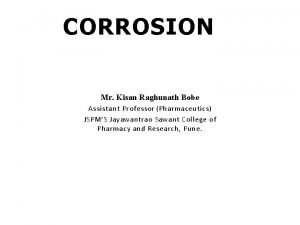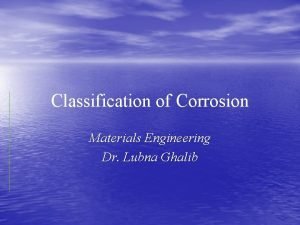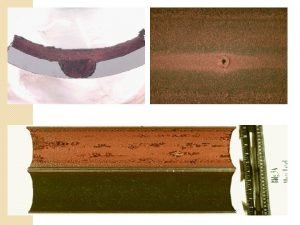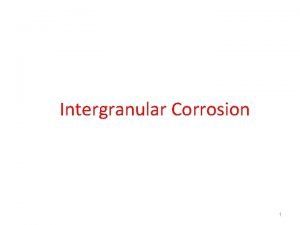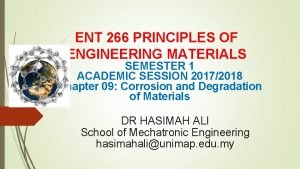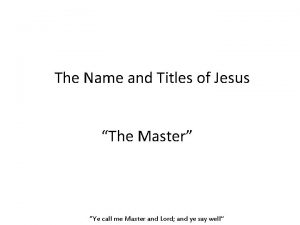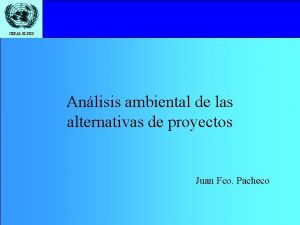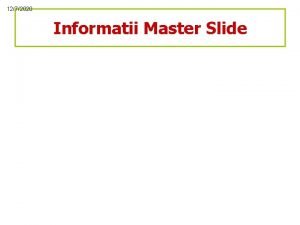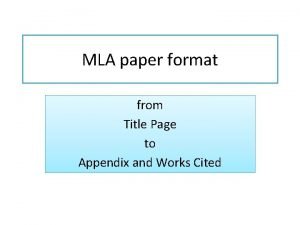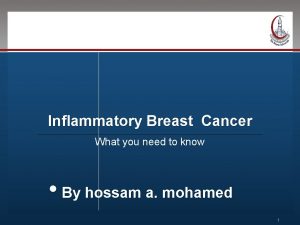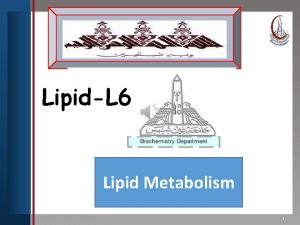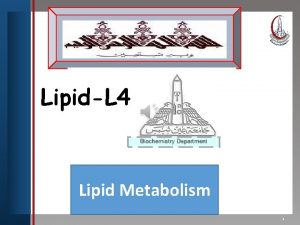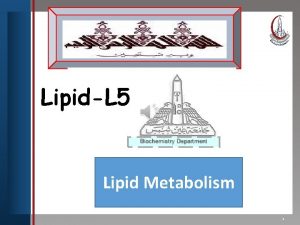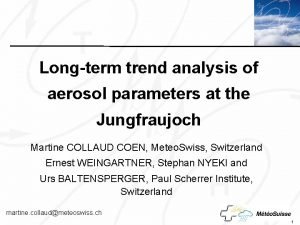Click to edit Master title style Corrosion Prevention



























- Slides: 27

Click to edit Master title style Corrosion Prevention for AST Bottoms Sujay Math and Chuck Barris Click to edit Master subtitle style Oklahoma City, OK. 2019 Do. D - Allied Nations Technical Corrosion Conference 1

Paper Title EFFECTIVE CORROSION PREVENTION STRATEGY FOR ABOVEGROUND STORAGE TANK SOIL-SIDE BOTTOM USING VAPOR CORROSION INHIBITORS AND CATHODIC PROTECTION 2019 Do. D - Allied Nations Technical Corrosion Conference 2

Presentation Outline • Background • Cathodic Protection Systems for ASTs • Experimental Studies • Results & Discussions • Summary 2019 Do. D - Allied Nations Technical Corrosion Conference 3

AST Soil-Side Bottom 2019 Do. D - Allied Nations Technical Corrosion Conference 4

Cathodic Protection and Vapor Corrosion Inhibitors • Cathodic Protection (CP) systems for tank bottoms • Impressed current anode (large diameter tanks) • Galvanic anode (small diameter tanks) • Protection is by polarization of tank bottom in negative direction with respect to native potential: tank bottom cathode • Vapor Corrosion Inhibitors (VCIs) • Applied as liquid slurry or dry powder, corrosion mitigation is by vapors • Protection is by chemical action (chemisorption) • Chemical molecules affect metal/soil interface and retard corrosion rate • VCI, CP both are effective corrosion control methods 2019 Do. D - Allied Nations Technical Corrosion Conference 5

Cathodic Protection System for ASTs • Commonly used anodes for CP systems • Mixed-Metal Oxide (MMO) anode for grid system • MMO anode in coke-breeze sock (Linear anodes) for concentric-ring system • Zinc or Magnesium anodes for galvanic CP system • Anode material selection • • • Anode Driving voltage and CP current demand Electrolyte Resistivity Anode Efficiency Practical Consideration: #’s, space constraints, electrolyte compatibility Life Expectancy 2019 Do. D - Allied Nations Technical Corrosion Conference 6

ICCP System for Large Diameter Tanks • Grid System • Concentric-ring System 2019 Do. D - Allied Nations Technical Corrosion Conference 7

GCP System for Small Diameter Tanks • Magnesium • Zinc 2019 Do. D - Allied Nations Technical Corrosion Conference 8

VCI Delivery Into Sand Base Chime Seal Applied CP Anode 2019 Do. D - Allied Nations Technical Corrosion Conference 9

Inhibitor Classification Corrosion Inhibitor Inorganic Cathodic Anodic Organic Mixed 2019 Do. D - Allied Nations Technical Corrosion Conference Adsorption 10

Inhibitor Classification Inorganic An od ic Anodic Type Cathodic Type Mixed Type Organic Ca th od ic Adsorption Action Anodic Type Cathodic Type Mixed Type 11

Results Potentiodynamic Polarization Scan Amine Carboxylates VCIs • Organic Anodic Type 2019 Do. D - Allied Nations Technical Corrosion Conference 13

Experimental Studies • Electrical Resistivity of Electrolytes • Potable Water, 3. 5% Na. Cl and 5% VCI • 4 -pin Miller Soil-Box Test • Weight Loss Coupons (2 -inch x 3. 5 -inch) • Cathodic Protection Current Distribution • • • Water Bath Setup (10 ft x 3 ft x 1. 3 ft) A 36 grade steel plate (120 -inch x 6 -inch x 0. 25 -inch) A 36 grade steel coupons (2 -inch x 0. 25 -inch) MMO ribbon anode grid system at 5 feet spacing DC power supply, constant current mode 2019 Do. D - Allied Nations Technical Corrosion Conference 13

Water bath setup for CP current distribution 2019 Do. D - Allied Nations Technical Corrosion Conference 14

Water bath setup for CP current distribution 2019 Do. D - Allied Nations Technical Corrosion Conference 15

Electrolyte Resistivity VCI Chemistries Amine-Carboxylate VCIs • Decreases Resistivity potable water p. H = 7. 4 • Increases p. H API 651: Desired Sand Pad Quality Property Desired Value Electrical Resistivity > 10, 000 ohmcm p. H Chloride Levels Sulfate Levels Sulfide Levels > 8. 0 < 10 ppm < 200 ppm < 10 ppm 2019 Do. D - Allied Nations Technical Corrosion Conference 14

Electrolyte Resistivity vs. Corrosivity Day 0 Potable Water Day 365 3. 5% Na. Cl 5% VCI Potable Water 3. 5% Na. Cl 5% VCI Electrolytes Potable Water 3. 5% Na. Cl 5% VCI Electrical Resistivity, ohm-cm 4400 21 47 2019 Do. D - Allied Nations Technical Corrosion Conference 17

Electrolyte Resistivity Wenner 4 -pin soil resistivity field test method Simulated Clean Sand: DI + Potable Water = 24830 ohmcm VCI Electrolyte: 2. 5 % VCI = 1337 ohm-cm 30000 Resistivity, ohm-cm 25000 20000 15000 10000 5000 0 Resistivity, ohm-cm 2019 Do. D - Allied Nations Technical Corrosion Conference Clean Sand 24830 2. 5% VCI 1337 18

Anode to Tank Bottom Resistance • NACE CP-4 Manual: AST CP system design sand resistivity ρ = 10, 000 to 30, 000 ohm-cm (design assumption) 2019 Do. D - Allied Nations Technical Corrosion Conference 19

Cathodic Protection Current Distribution • Total surface area of steel plate with coupons = 5. 15 ft 2 • CP current applied • 5 m. A (current density = 1 m. A/ft 2) • 10 m. A (current density = 2 m. A/ft 2) • 40 m. A (current density = 8 m. A/ft 2) • Current distribution from anode • Single point anode • Anode grid system (5 ft. c/c) 2019 Do. D - Allied Nations Technical Corrosion Conference 20

Anode Throw and Spacing • NACE CP-4 Manual: AST CP system design Rule of Thumb, L = 3. 5 d 2019 Do. D - Allied Nations Technical Corrosion Conference 21

Simulated Sand Electrolyte: Single Point Anode 2019 Do. D - Allied Nations Technical Corrosion Conference 22

VCI Electrolyte: Single Point Anode 2019 Do. D - Allied Nations Technical Corrosion Conference 23

Simulated Sand Electrolyte: Anode Grid System 2019 Do. D - Allied Nations Technical Corrosion Conference 24

VCI Electrolyte: Anode Grid System 2019 Do. D - Allied Nations Technical Corrosion Conference 25

Conclusions 1. VCIs lower the electrical resistivity of electrolytes due to their ionic strength. Generally, the lower electrical resistivity is indicative of corrosivity; however, this concept does not apply to sand plus VCI electrolytes. 2. The coupon immersion test results showed corrosion on potable water and 3. 5% Na. Cl electrolytes, whereas no corrosion is observed on 5% VCI electrolyte coupon, for 365 days of continuous immersion. The electrical resistivity of 3. 5% Na. Cl and 5% VCI electrolyte was similar. 3. Addition of VCIs to the simulated clean sand electrolyte lowered the resultant electrical resistivity of the electrolyte. This effect aided in lower CP anode ground bed resistance and resulted in uniform CP current distribution and polarization levels on the tank bottom plate. 4. The current required to achieve NACE recommended 100 -m. V criteria for effective CP was lower for the VCI electrolyte. 5. Using VCI and CP in combination proves to be an effective corrosion protection strategy for aboveground storage tank soil-side bottoms resting on sand pads. 2019 Do. D - Allied Nations Technical Corrosion Conference 26

THANKYOU 2019 Do. D - Allied Nations Technical Corrosion Conference 27
 Click to edit master title style
Click to edit master title style Informaatika mitteinformaatikutele
Informaatika mitteinformaatikutele Title style
Title style Click to edit master title style
Click to edit master title style Primary prevention secondary prevention tertiary prevention
Primary prevention secondary prevention tertiary prevention Hard edits
Hard edits Dry corrosion and wet corrosion
Dry corrosion and wet corrosion Differentiate between wet and dry corrosion
Differentiate between wet and dry corrosion What is season
What is season Corrosion prevention casing filler
Corrosion prevention casing filler Intergranular corrosion prevention
Intergranular corrosion prevention Prevention of corrosion
Prevention of corrosion Internet safety
Internet safety Cyber safety
Cyber safety Click clever click safe
Click clever click safe Click clever click safe
Click clever click safe Master title style
Master title style Master title style
Master title style Add your title here
Add your title here Click to add title
Click to add title Click to add title ne demek
Click to add title ne demek Who taught how
Who taught how Master title
Master title What is a slide title master pair
What is a slide title master pair Prefatory part of report
Prefatory part of report Title title
Title title Apa first page
Apa first page Appendix format example
Appendix format example






